A
Age restrictions
You must be over 21 years of age to be able to drink legally in San Francisco. The minimum legal age for smoking is 18 years old. Expect to have to show I.D. to buy alcohol in bars, clubs, and restaurants.

Chinatown and the Transamerica Pyramid
Nowitz Photography/Apa Publications
C
Children
One of the great things about traveling with children in San Francisco is that many of the city’s attractions are suitable for people of all ages. A stroll across the Golden Gate Bridge, exploring the markets of Chinatown, cresting a hill aboard a cable-car, or zigzagging down legendary Lombard Street are all crowd-pleasers for young and old alike. San Francisco is a very kid-friendly city with an abundance of state-of-the-art playgrounds, restaurants that offer children’s menus (and often crayons), bathrooms equipped with changing tables for babies, and lots of wide open spaces for running around in. Most hotels allow children to stay in parents’ rooms at no additional charge (though there is usually an age limit for this) and will provide a rollaway bed or portable crib as needed.
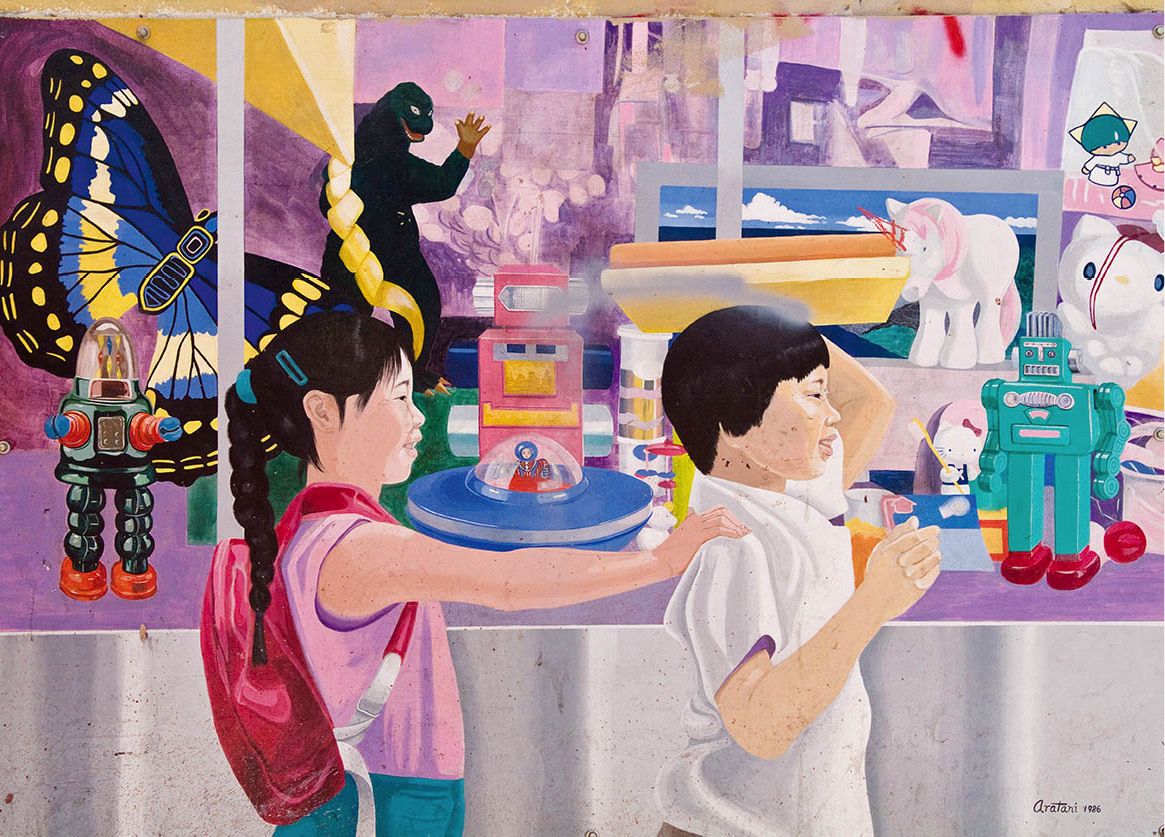
Mural on Ross Street
Nowitz Photography/Apa Publications
Climate
San Francisco weather can change significantly from hour to hour and between neighborhoods. Springs are pleasantly warm and sunny (average high in April 63°F/17°C; low 50°F/ 10°C), while summers can be overcast and typified by fog (average high in July 66°F/19°C; low 54°F/12°C). Come September and October, the summer chill is replaced with beautifully mild, sunny days (average high in September 70°F/21°C; low 56°F/14°C). Rainstorms (no snow) appear in December and January, though crisp, sunny days offer breaks from the damp and dreary ones (average high in January 56°F/ 14°C; low 46°F/8°C).

Catching the ferry
Nowitz Photography/Apa Publications
Clothing
Plan for variable weather and bring clothes that can be layered, as well as comfortable walking shoes: the city’s hills are hard to climb in high heels. A raincoat and sturdy umbrella are vital for winter months, when windy rainstorms are common. The city’s casual, come-as-you-are vibe means jeans, T-shirts, and tennis shoes are ubiquitous on streets and in many restaurants and entertainment venues. However, fancier eateries and nightclubs warrant something a bit smarter.
Crime and safety
As a major city, San Francisco does see some crime, and travelers should exercise good common sense, avoiding seedy neighborhoods and being cautious about walking around alone and at night. Avoid parks after dark. Neighborhoods with less safe reputations include the Tenderloin, Civic Center, Western Addition, the Lower Haight, the Mission south of 24th Street, South of Market above 5th Street, and Bayview districts.
Customs
Adult visitors staying longer than 72 hours may bring the following into the country duty-free: 1 liter of wine or liquor; 100 cigars (non-Cuban), or 3lbs of tobacco, or 200 cigarettes; and gifts valued under $100.
Pay careful attention to restrictions on bringing food into the US, as violating them results in heavy fines. Agricultural items − including anything with meats, fruits, vegetables, plants, soil, and products made from animal or plant materials − are not permissible. As a general rule, bakery items, certain cheeses, condiments, vinegars, oils, packaged spices, honey, coffee, and tea are admissible. Visitors may also arrive and depart with up to $10,000 currency without needing to declare it. For the most up-to-date information on what you can bring with you, refer to the U.S. Customs and Border Protection website (www.cbp.gov).
D
Disabled travelers
The city’s topography presents obvious challenges to those who have mobility problems, but San Francisco is relatively disabled-friendly. The San Francisco Travel Association maintains a TDD/TYY information line (392-0328) and offers a free accessibility guide (www.sanfrancisco.travel/accessibility/San-Francisco-Access-Guide.html). For guidance on public transportation, request the Muni Access Guide from Muni Accessible Services Programs (701-4485 or TTY 701-4730). Handicapped parking zones are clearly marked throughout San Francisco with signage and blue curbs; obtain a temporary permit at the Department of Motor Vehicles at 1377 Fell Street (bring along your state-of-origin permit/plaque with photo ID; fee $6).
Societies that can provide useful information include MossRehab (tel: 800-2255-6677; www.mossresourcenet.org) and the Society for Accessible Travel & Hospitality (SATH; tel: 212-447-7284; www.sath.org).
E
Electricity
Electricity in the U.S. is 110 Volts, 60 Hertz A.C. Flat-blade, two-pronged plugs are typical, though some points have three-pronged sockets. Most foreign appliances need a transformer and/or plug adapter.
Embassies/consulates
Australia: tel: 644-3620; www.dfat.gov.au.
Canada: tel: 834-3180; http://can-am.gc.ca/san-francisco/.
Ireland: tel: 392-4214; http://www.consulateofirelandsanfrancisco.org.
France: tel: 397-4330; www.consulfrance-sanfrancisco.org
Germany: tel: 775-1061; www.germany.info/SanFrancisco.
New Zealand: tel: 650-342-4443; www.nzembassy.com.
South Africa: tel: 202-232-4400; www.saembassy.org.
U.K.: tel: 617-1300;
www.gov.uk/government/world/organisations/british-consulate-general-san-francisco.
Details for other embassies and consulates can be found by a simple Google search.
Emergency numbers
For ambulance, fire, or police, dial 911; if you need to call from a public phone, no coins needed.
Environmental issues
With an extensive recycling program, a bike-riding population, and countless campaigns to “green” the city by planting trees and native species on its rooftops and public spaces, San Francisco has rightly developed a reputation for being an eco-friendly city. But as much as it tries, it is also a densely populated metropolitan area that carries the inevitable environmental concerns, ranging from air quality to water shortages. San Francisco’s greatest threat lies just below the surface in the network of seismic faults that occasionally jolt the city and can cost lives and millions of dollars’ worth of damage.
F
Festivals
January
San Francisco Sketchfest. National headliners, local favorites and up-and-coming groups all converge for a month-long spree of sketch, improv, stand-up and alternative comedy.
Dr Martin Luther King Jr.’s Birthday Celebrations. Events across town.

Chinese New Year parade
Dreamstime
February
Chinese New Year Parade. With floats, firecrackers, and a fantastic lion orchestrated by 100 costumed dancers, this annual celebration of the lunar new year has become one of the largest events of its kind outside Asia. www.chineseparade.com.
Noise Pop. An indie music festival going strong for over 20 years.
March
St Patrick’s Day Parade. A full day of celebration at Civic Center (and bars around town, especially in the Financial District) and one of the longest-running parades in the U.S.
April
Cherry Blossom Festival. Two weekends of Japanese art, music, and food. www.nccbf.org.
San Francisco International Film Festival. www.sfiff.org.
May
Bay to Breakers. San Francisco’s 12km Bay to Breakers is the oldest consecutively run annual footrace in the world, held since 1912. Participants don outrageous costumes and wind their way through the city, from the Embarcadero to Ocean Beach. www.baytobreakers.com.
Carnaval. Hispanic Mission district comes alive with floats, dancers, and Latino music. www.carnavalsf.com.
San Francisco International Beer Festival. www.sfbeerfest.com
June
Escape From Alcatraz Triathalon. www.escapefromalcatraztriathlon.com
Haight Street Fair. One of the city’s biggest street fairs, with 200+ booths offering foods and crafts, and live music all day. www.haightashburtystreetfair.org.
North Beach Festival. The city’s oldest street fair. www.sresproductions.com

The annual pride celebration and parade
Dreamstime
San Francisco Pride Celebration and Parade. A weekend of events including a huge Sunday parade. www.sfpride.org.
San Francisco Silent Film Festival. www.silentfilm.org.
Stern Grove Festival. Classical, jazz, world music, and picnics (June–Aug). www.sterngrove.org.
July
Fourth of July Waterfront Festival. Independence Day celebrations feature live music and firework displays over the bay. www.fishermanswharf.org.
Fillmore Jazz Festival. www.fillmorejazzfestival.com
Jewish Film Festival. www.sfjff.org.
San Francisco Shakespeare Festival. Free Shakespeare in the Park and programs for youngsters, from July through September. www.sfshakes.org.
August
Nihonmachi Street Fair. A celebration of the Bay Area’s Asian- and Pacific-American communities. www.nihonmachistreetfair.org.
Outside Lands Festival. A huge 3-day music festival in Golden Gate Park. www.sfoutsidelands.com.
September
Comedy Day. Free stand-up in Golden Gate Park. www.comedyday.com.
Free Opera in the Park. “Greatest hits” performed by the San Francisco Opera in Golden Gate Park and live performances simulcast in AT&T Park. Free.
San Francisco Fringe Festival. Independent theater, performance art, and comedy held in various venues. www.sffringe.org.
Folsom Street Fair. San Francisco’s R-rated BDSM and leather subculture street festival. www.folsomstreetfair.com
October
Fleet Week. Fisherman’s Wharf welcomes the U.S. Navy. Highlights include the Blue Angels airshow. www.fleetweek.us
Hardly Strictly Bluegrass Festival. Some of the biggest names in bluegrass, country, and rockabilly perform free for three days in Golden Gate Park. www.hardlystrictlybluegrass.com.
Litquake. A 9-day literary event for booklovers, filled with readings, panel-discussions, and literary bar crawls. www.litquake.org
November
Christmas Tree Lighting Ceremonies. The city lights up in Union Square on the Saturday after Thanksgiving.
Día de los Muertos. The Mexican Day of the Dead is celebrated with drummers, altars, and dancing skeletons. www.dayofthedeadsf.org.
December
Festival of Lights. The lighting of a Hanukkah menorah in Union Square.
New Year’s Eve. City-wide celebration with live music and fireworks.
G
Gay travelers
San Francisco is internationally known as one of the world’s most welcoming places for gays and lesbians, and this accepting attitude prevails in all neighborhoods. The most predominantly gay district is the Castro. The best source for information are two free weeklies: the Bay Area Reporter (www.ebar.com) and the Bay Area Times (www.sfbaytimes.com). Also consult www.sanfrancisco.travel/lgbt/. The Center (1800 Market Street; tel: 865-5555; www.sfcenter.org; Mon–Thur noon–10pm, Fri noon–6pm, Sat 9am–6pm; free) is a vital nexus for the LGBT community, and has an information desk, library, web access, bulletin boards, and a café.
Guided tours
San Francisco City Guides (www.sfcityguides.org) offers a range of free, volunteer-led tours, covering both neighbourhood overviews and specialty topics such as Alfred Hitchock, architecture, the 1906 earthquake, and theatre. Foot! (www.foottours.com), Wok Wiz Chinatown Tour (www.wokwiz.com), and Cruisin’ the Castro (www.cruisinthecastro.com) also offer tours at reasonable prices. Several bus tour companies also offer daily tours in and around the city; see www.sanfrancisco.travel for a full list.
For guided tours outside of the Bay Area, Green Tortoise (tel: 800-8678-6473; www.greentortoise.com) is an adventurous option; each trip makes frequent stops at national parks or other points of interest, and their buses have communal areas that convert to reclined sleeping quarters at night. The San Francisco headquarters also house the Green Tortoise hostel.

Pharmacy sign
Nowitz Photography/Apa Publications
H
Health
Drugstores (pharmacies)
Some medicines that are available over the counter in your home country may require a prescription in the U.S. There are branches of the useful 24-hour Walgreens drugstore chain (www.walgreens.com) at 498 Castro Street (tel: 861-3136) and 3201 Divisadero Street (tel: 931-6417). Additional Walgreens and Rite Aid (www.riteaid.com) branches are open late into the evening.
Insurance and hospitals
Healthcare is private and can be very expensive, especially if you need to be hospitalized. Foreign visitors should always ensure that they have full medical insurance covering their stay before traveling to the U.S. The following hospitals have 24-hour emergency rooms:
California Pacific Medical Center
Castro Street at Duboce Avenue; tel: 600-6000; www.cpmc.org; Metro: N to Duboce.
Saint Francis Memorial Hospital
900 Hyde Street; tel: 353-6300; www.saintfrancismemorial.org; bus: 1, 2, 19, 27.
San Francisco General Hospital
1001 Potrero Avenue; tel: 206-8000; www.sfdph.org; bus: 9, 10, 33, 48, 90.
UCSF Medical Center
505 Parnassus Avenue; tel: 476-1000; www.ucsfhealth.org; Metro: N to UCSF.

Using the Wi-Fi connection at a local café
Nowitz Photography/Apa Publications
I
Internet
Many cafés have Wi-Fi hotspots, although sometimes there are time limits on usage. If you’re looking for not only free internet access but also a computer, public library branches are your best bet. (San Francisco Public Library; tel: 557-4400; http://sfpl.org).
M
Media
The largest regional newspaper is the San Francisco Chronicle (www.sfgate.com); its Sunday “Pink Pages” list art, music, and entertainment events. Free alternative weeklies are found in newspaper boxes, cafés, and bars. The four main weeklies are the San Francisco Bay Guardian (www.sfbg.com), SF Weekly (www.sfweekly.com), San Francisco Bay Times (www.sfbaytimes.com), and Bay Area Reporter (www.ebar.com). The last two are gay- and lesbian-oriented, and most easily found in the Castro. The city’s magazines include San Francisco Magazine (www.modernluxury.com/sanfrancisco) and 7x7 (www.7x7.com).
Money
Currency
The dollar ($) is divided into 100 cents (¢). The coins are the penny (1¢), nickel (5¢), dime (10¢), quarter (25¢), and the less common half-dollar (50¢) and $1 coins. The banknotes are the $1, $5, $10, $20, $50, and $100 bills.
Banks and currency exchange
Bank hours are generally Monday to Friday, from about 9am to 5pm. Some open on Saturday mornings. It’s best to change foreign currency at airports, major banks downtown, or American Express offices.
ATMs
ATMs are at banks, some stores, and bars, and charge varying usage fees: check also with your bank at home. Debit card use on purchases at major grocery and drugstores allows you to get cash back.
Credit cards
Credit cards are accepted at most restaurants, hotels, and stores.

San Francisco is a great city for walking
Nowitz Photography/Apa Publications
Traveler’s checks
With the popularity of ATMs, credit cards, and debit cards, traveler’s checks are increasingly less common. However, banks and some stores, restaurants, and hotels do accept traveler’s checks in U.S. dollars. If yours are in foreign denominations, they must first be changed to dollars. Un-exchanged checks should be kept in your hotel safe. Record the checks’ serial numbers in a separate place to facilitate refunds of lost or stolen checks.
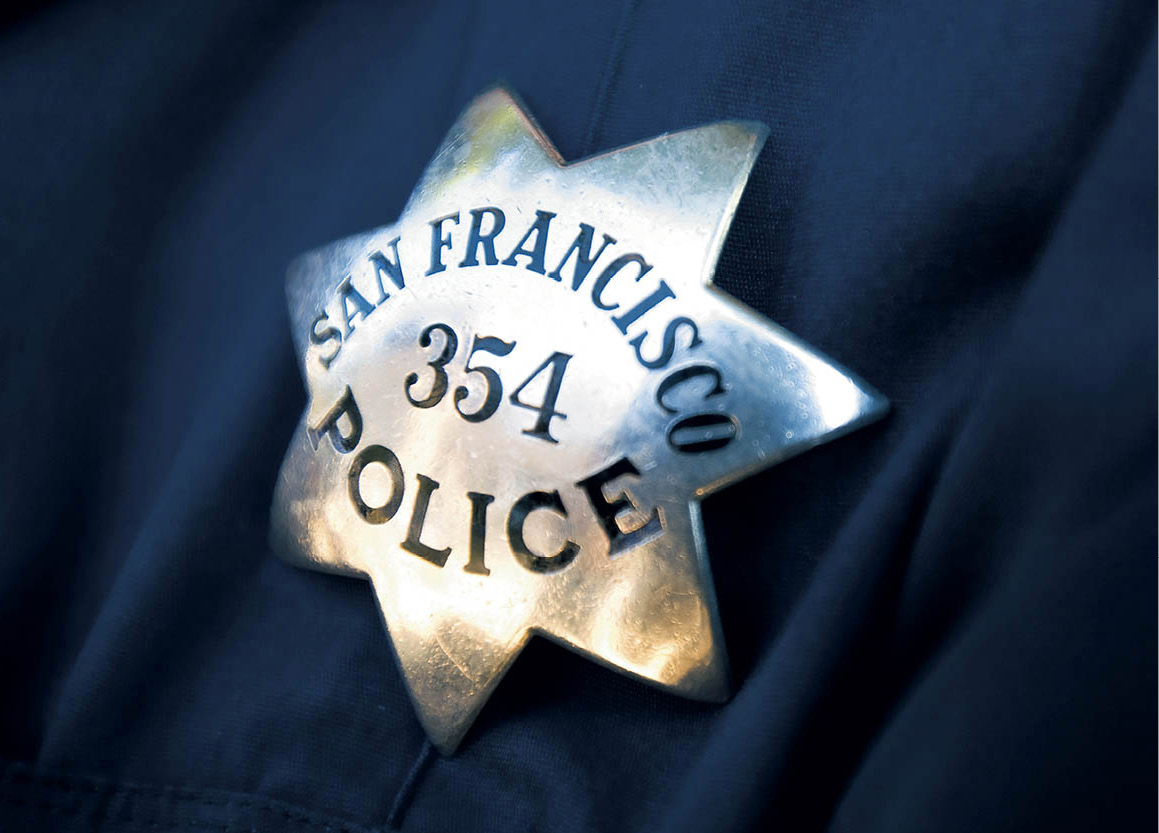
Police badge
Nowitz Photography/Apa Publications
P
Police
The emergency police number is 911 (no coins needed). The non-emergency number for the police is 553-0123.
Postal services
Post offices open at 8–9am and close at 5–6pm, Monday through Friday; the post office in the Macy’s department store on Union Square (tel: 956-0131) is also open on Sunday. Use the Civic Center post office for general-delivery mail (poste restante).
U.S. Postal Service
Tel: 800-275-8777; www.usps.com.
Civic Center Post Office
101 Hyde Street; tel: 563-7284; Mon–Fri 9am–5pm.
Public holidays
The U.S. has shifted most public holidays to the Monday closest to the actual dates, thereby creating a number of three-day weekends. National holidays are:
New Year’s Day January 1
Martin Luther King Jr. Day 3rd Monday in January
President’s Day 3rd Monday in February
Memorial Day Last Monday in May
Independence Day July 4
Labor Day 1st Monday in September
Columbus Day 2nd Monday in October
Veterans Day November 11
Thanksgiving Day 4th Thursday in November
Christmas Day December 25
S
Smoking
Be careful where you light up in San Francisco: smoking laws are strict, and smoking is banned in many public places such as offices, shops, restaurants, and bars. Many hotels are completely non-smoking. The minimum legal age for smoking is 18 years old.
T
Taxes
In San Francisco, an 8.75 percent sales tax is added to the price of all goods and services; in surrounding cities, the sales tax ranges from 8–9 percent. Hotels charge a 14 percent tax that generally will not be included in quoted rates.
Telephones
Local calls are inexpensive; long-distance calls are decidedly not. Public phones accept coins and calling cards. The San Francisco area code is 415, which you only need to dial from outside the city; the country code is 1. Toll-free numbers begin 1-800, 1-888, 1-877, or 1-866.
Directory enquiries: 411.
U.S. calls outside your area code: 1 + area code + phone number.
International calls: 011+ country code + phone number.
Operator: 0 for assistance with local calls; 00 for international calls.
Time zones
San Francisco is on Pacific Standard Time. P.S.T. is three hours behind Eastern Standard Time (New York) and eight hours behind Greenwich Mean Time (London).

Tipping is expected in bars and restaurants
Nowitz Photography/Apa Publications
Tipping
Tipping in the U.S. is different from many other places in the world. Most wait staff and bartenders make very low wages and depend on tips for survival. If you tip badly, don’t expect good service if you return.
Restaurants: 18–20 percent (even if you were dissatisfied with the service you should tip at least 10 percent). Most restaurants add a service charge automatically for parties of six or more. A quick way of working it out is to double the tax and round up or down depending on level of satisfaction.
Taxis: 10–15 percent.
Bars: 10–15 percent, or at least $1–2 per drink.
Coat check: $1–2 per coat.
Door attendants: $1–2 for hailing a cab or bringing in bags.
Porters: $1–2 per bag (more if you packed bricks).
Valet parking: $2–3.
Concierge: $5–10.
Maids: $3–5 per day.
Hairdressers and salons: 15–20 percent.
Tourist information
Visitor Information Center of San Francisco, 900 Market Street; tel: 391-2000; www.sanfrancisco.travel; Nov–Apr Mon–Fri 9am–5pm, Sat 9am–3pm (May–Oct also Sun 9am–3pm). The center is down the stairway near the cable-car turntable at Market and Powell streets, and supplies brochures, maps, and helpful answers In 14 languages. You can also purchase transit passes here. Call for a listing of monthly events.
California Welcome Center, Pier 39, 2nd level, www.visitcalifornia.com.

Stopping to admire the view over the bay
Nowitz Photography/Apa Publications
Transportation
A major hub for flights from all over the world, San Francisco is easily reached by air, while visitors from other parts of the United States can opt to travel by rail or bus. Once here, the city and its outlying areas are comfortably navigable by public transportation.
In San Francisco, a car is not generally necessary to see the sights, and can prove to be something of a hassle, especially when such great views are provided on cable-cars from the tops of the city’s hills. Efficient, affordable, and comprehensive, San Francisco’s public transportation network makes it easy to be green.
Getting to San Francisco
By air
San Francisco International Airport (SFO; 1 McDonnell Road; tel: 650-821-8211; www.flysfo.com) is the major international airport for northern California. From Europe, all the major airlines offer non-stop flights or connections via New York, Chicago, or Los Angeles. It also receives non-stop, or one-stop, flights from all the principal Pacific airports. For foreign travelers, many of the U.S. airlines offer deals for visiting several American cities.
Despite being 13 miles (21km) away, downtown San Francisco is easy to reach. Taxis and shuttles line the inner circle of the transportation zones of the Arrivals/Baggage Claim Level, while BART (Bay Area Rapid Transit), located at the Departures/Ticketing Level at the International Terminal and accessible from the Domestic Terminal by the Airtrain, takes passengers to downtown San Francisco and across the bay to various cities, for a minimal cost. The area is blanketed by Wi-Fi, which can be used for a fee.
The Oakland International Airport (OAK; 1 Airport Drive, Oakland; tel: 510-563-3300; www.flyoakland.com) is located 4 miles (6km) south of the city’s downtown, and is accessible by BART (take AirBART shuttles from the Oakland Coliseum BART station to the airport for $3). A hub for low-cost carriers, OAK is often a more economical alternative to the bigger and busier SFO.
The smallest of the three airports, Mineta San Jose International Airport (SJC; 1732 North 1st Street, San Jose; tel: 408-501-7600; www.sjc.org) is nearly 50 miles (80km) from downtown San Francisco.
Carbon-offsetting
Every day, airplanes dump 90 million lbs (41 million kg) of carbon dioxide and other noxious greenhouse gasses into the atmosphere. To “offset” their share of the carbon footprint, travelers can buy carbon credits according to the distance traveled. Credits invest money into renewable energy and energy efficiency programs. For more information visit www.carbonfund.org.
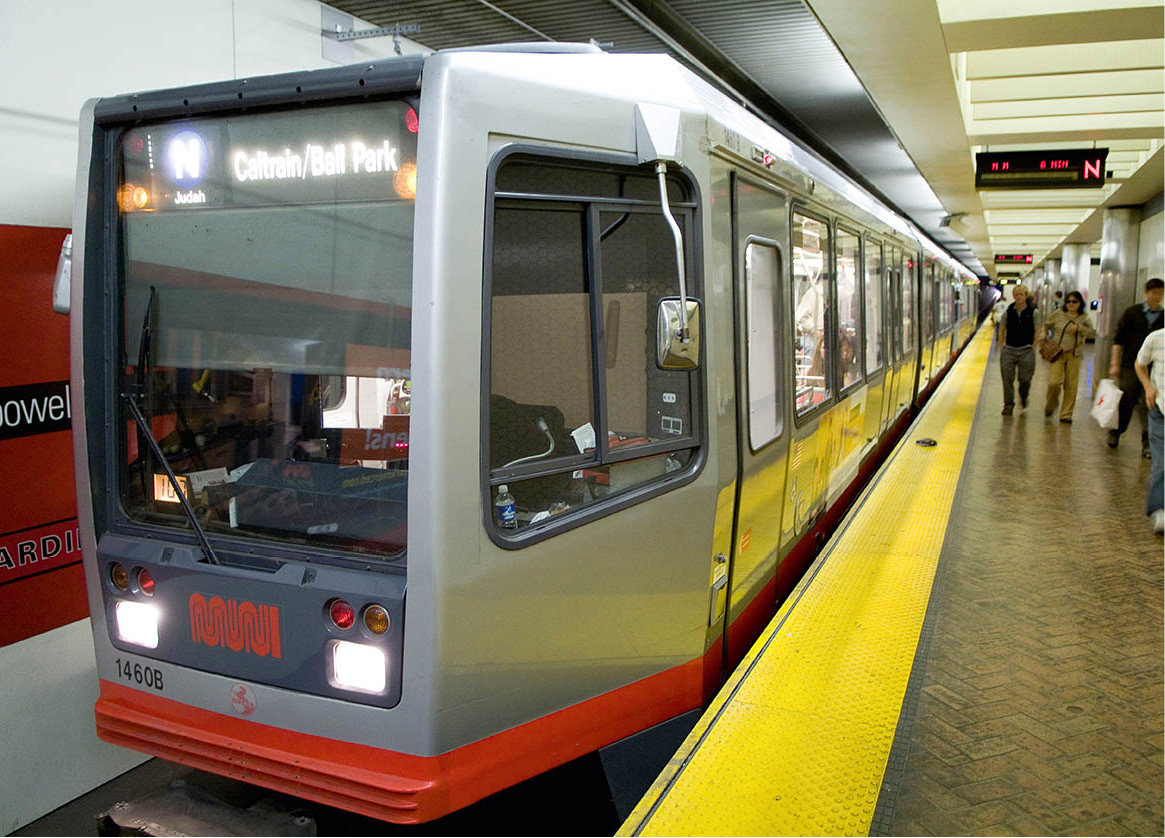
Bay Area Rapid Transport
Nowitz Photography/Apa Publications
By train
While Amtrak (Emeryville depot, 5885 Horton Street, Emeryville; tel: 510-450-1087 (information line: 800-872-7245; www.amtrak.com), the cross-continental passenger rail line, does not connect directly to San Francisco, it has a free shuttle to deliver passengers to and from the depot in Emeryville, located in the East Bay. For longer trips, Amtrak can be frustrating, as passenger trains share the rail lines with, and must defer to, the freight lines, causing significant delays. Nonetheless, it still remains a green alternative to air travel, and some routes are quite picturesque.
By bus
Downtown, just east of Market Street, the Transbay Terminal (425 Mission Street; information line: 800-231-2222; www.greyhound.com; tel: 495-1555) is a major hub for the transcontinental Greyhound bus service.
By car
Despite congestion, myriad hills, and the problem of what to do with your vehicle upon arriving, San Francisco is easy to reach by car. Interstates 101 and 80 pass through the city, while Interstates 5 and 99 are not too far away in the Central Valley. State Highway 1 runs along the coast of California and the western part of San Francisco.
Getting around San Francisco
For help navigating the entire Bay Area public transit system, including Muni buses and metro streetcars, and BART, call 511 or look online at www.511.org and www.sfmta.org; 511 offers assistance with planning trips using public transportation, traffic, and drive time information, tips for traveling with bikes, and links to various municipal transit agencies.
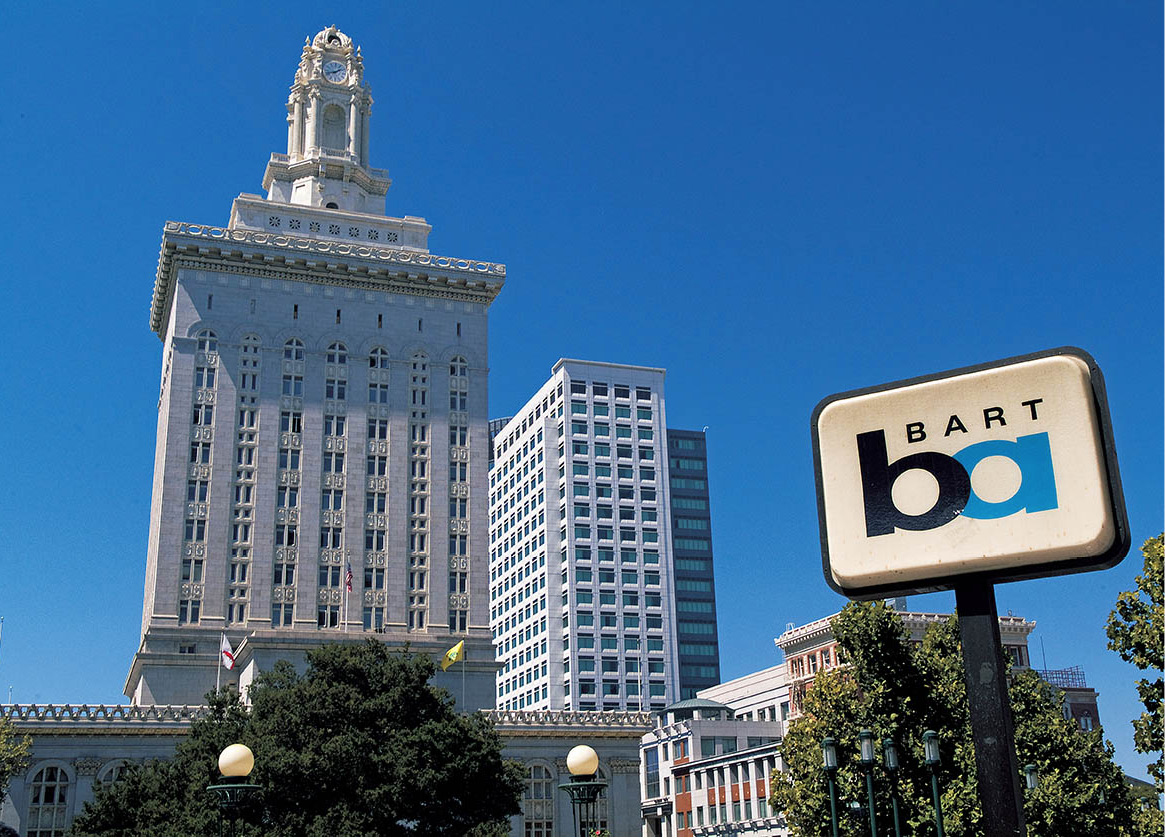
Bart station in Berkeley
Nowitz Photography/Apa Publications
BART (Bay Area Rapid Transit)
Fast, quiet, and efficient, BART (www.bart.gov) allows passengers to get around the Bay Area in comfort. All BART lines travel through San Francisco, extending to San Francisco International Airport, and under the bay to Oakland, Berkeley, and beyond. Its stations provide maps that clearly explain routes and fares, and automatic ticketing machines from which passengers can purchase their tickets. If they do not have the exact change, passengers may carry a balance on their ticket for future use, or utilize one of the change machines also located in the stations.
Four BART lines run through downtown and provide the quickest way to travel between downtown and the Mission District, or to reach Oakland and Berkeley.
Buses and metro
Muni, the San Francisco Municipal Transit Agency, runs the city’s orange and white diesel and electric buses, streetcars which run on lightrail lines underground through downtown, the historic F-line streetcars (comprising a collection of vintage trams from all over the world), and of course, the cable-cars. “Muni” can be used to refer to the system as a whole and also to the metro streetcars. The Muni Owl service replaces normal service on some lines between 1–5am.
Purchasing a map is highly recommended and will make a stay in San Francisco infinitely simpler. They are available at the Muni kiosks at the Powell and Market, Hyde and Beach, and Bay and Taylor cable-car terminals, as well as the San Francisco International Airport airport information booth near baggage claim, and in some stores, such as the Walgreens at 125 Powell Street and the Alexander Book Company at 50 2nd Street. They are also posted at many Muni Metro and bus stops.
For all Muni Metro and bus lines, adult fare is $2. Exact change is necessary, but transfer slips are given, allowing you to transfer different Muni Metro or bus lines within a 90-minute timeframe. Ride without limit on Muni-operated transport, including the cable-cars, by using 1-, 3-, or 7-day visitor “Passports” (costing $15, $23, and $29, respectively). These are good on Muni buses and metro only, so BART tickets will need to be purchased separately. They are sold at the Visitor Center at Powell and Market, the information booth near baggage claim at San Francisco International Airport, major cable-car terminals, and most Walgreens and Cole Hardware stores. For a list of other places where passes can be purchased, and for route planning and general information, see www.sfmta.com. For up-to-the-minute information on when the vehicle you are waiting for will arrive, refer to www.nextmuni.com.

Embarcadero trains
Nowitz Photography/Apa Publications
Taking a cable-car ride is one of the classic San Francisco experiences. Cable-cars are also operated by Muni, but are the exception to most of the Muni rules. Fares can be purchased at the kiosk at each terminal, or when you board. Drivers do give exact change (it’s best to have small bills) but no transfers − if you depart one vehicle, you must pay full fare to board another. They are also considerably more expensive at $6 per trip. Often crowded with tourists, they ride over San Francisco’s famous hills. Waits to board at the cable-car turnaround at 5th and Market streets can be long, so locals often walk several blocks up Powell to board at another stop. Another option if you’re pressed for time is to board the California line at Van Ness or the Ferry Building; the fine views on this route are of Nob Hill, Chinatown, and the Financial District.
CityPASS
CityPASS is a 7-day pass (www.citypass.com; adult $86, child $64) that includes the benefits of a Visitor Pass (unlimited rides on Muni, Muni Metro, and cable car rides) but also provides one admission ticket over a 9-day period to various points of interest in San Francisco, including the California Academy of Sciences, a Blue and Gold Fleet bay cruise, Exploratorium or De Young Museum, and Aquarium of the Bay or Monterey Bay Aquarium. There’s also an option to substitute Alcatraz for the bay cruise.
Taxis
Taxis are a convenient but expensive way to get about when the majority of San Francisco’s public transit shuts down around 12.30am. They hover around popular tourist or nightlife spots, but in out-of-the-way locations it is advisable to call a radio-dispatched taxi. Drivers prefer cash, but take credit cards as well.
DeSoto Cab Company, tel: 970-1300.
Green Cab, tel: 626-4733.
Luxor Cab Company, tel: 282-4141.
Yellow Cab, tel: 333-3333.
Cycling
Around San Francisco, there are plenty of places to ride that are reasonably flat and far from exhaust fumes. Cycling through Golden Gate Park is a favorite, especially on Sundays, when many of the roads are blocked to cars. Riding along the Golden Gate Promenade and crossing the Golden Gate Bridge is a stunning ride, although difficult if the wind is up. For maps and additional resources, refer for www.sfbike.org.
Bikes can be rented hourly or for the day, with rates varying by type of bike, but usually $20–60 per day and $7–10 per hour. Bay Area Bike Share (www.bayareabikeshare.com) is an alternative.
Bay City Bike
501 Bay Street, 2661 Taylor Street, 2828 Jones Street, and 1325 Columbus Avenue; tel: 346-2453; http://baycitybike.com; daily from 8am.
Blazing Saddles
1095 Columbus Avenue, including a number of locations on Fisherman’s Wharf; tel: 202-8888; www.blazingsaddles.com; daily from 8am.
Golden Gate Bike and Skate
3038 Fulton Street; tel: 668-1117; summer: Mon–Fri 10am–6pm, Sat–Sun until 7pm, winter: Mon–Fri 10am–5pm, Sat–Sun until 6pm.
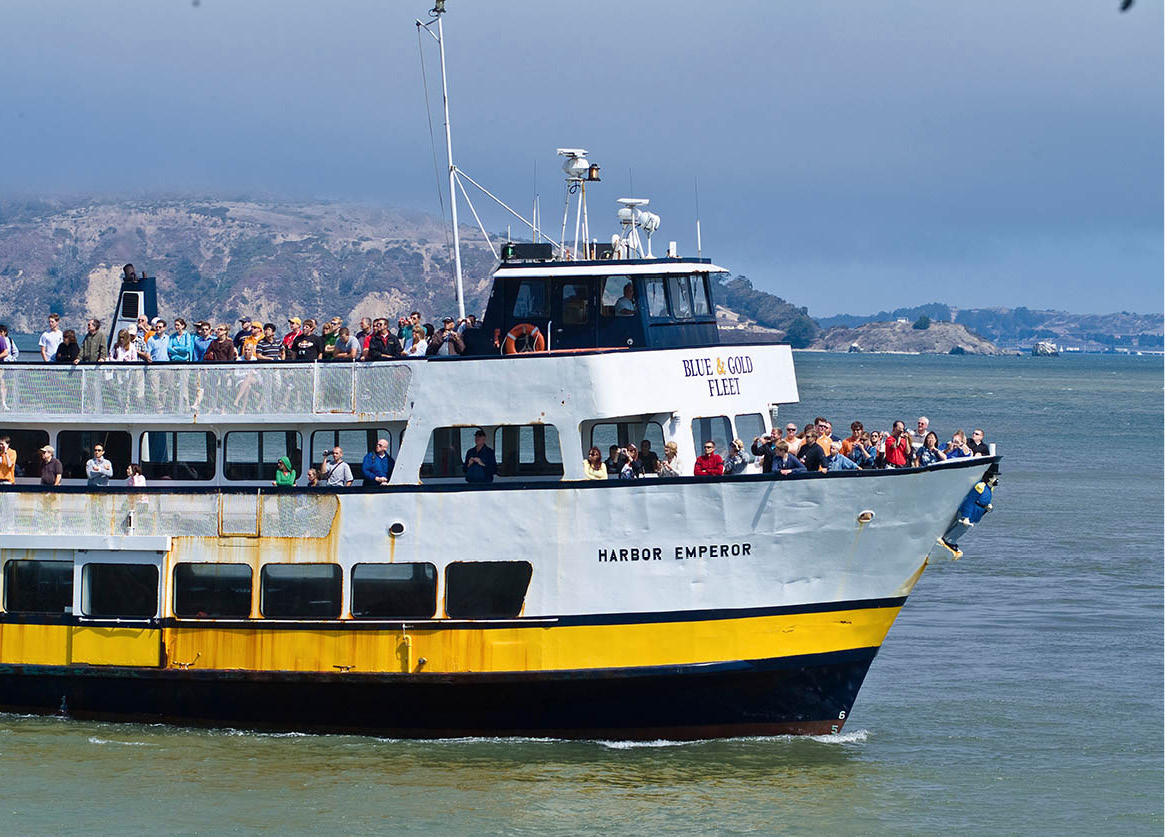
Ferry to Alcatraz
Nowitz Photography/Apa Publications
Driving
San Francisco is a difficult city to drive and park in, often taxing the most experienced local drivers. It is crisscrossed by one-way streets, and the fast-paced driving culture can easily unnerve any visitor. If it is necessary to rent a car, all the major car-rental companies have outlets at San Francisco International Airport and around the city.
Avis Rental Car
Tel: 800-230-4898; www.avis.com.
Enterprise
Tel: 800-261-7331; www.enterprise.com.
Hertz Rent A Car
Tel: 800-654-3131; www.hertz.com.

Students at Berkeley
Nowitz Photography/Apa Publications
Walking
The best way to see San Francisco is by walking. Only 7 miles by 7 miles (127 sq km), it is easy to cover great distances while seeing many different neighborhoods and glimpsing how residents live. Walking the hills provides spectacular views of the city and the rest of the Bay Area. Bring a map, comfortable shoes, and an extra layer of clothing in case the infamous San Francisco fog rolls in. Always be alert while crossing intersections. Taxis can be particularly aggressive.
Getting Around the Bay Area
Caltrain
Caltrain (main San Francisco depot, 700 4th Street; information line: 800-660-4287; www.caltrain.org) runs alongside Highway 101 to San Jose, with limited extensions all the way to Gilroy. It is largely a commuter train, but for visitors headed to the Peninsula or the South Bay, it is an enjoyable ride; there’s plenty of comfortable seating, an upper deck with tables, and a car to accommodate passengers with bikes. Caltrain’s terminus is near the AT&T Ballpark and many San Francisco Muni bus and Metro lines, helpful for getting passengers around the city. Every Caltrain stop has an electronic ticket machine at which passengers can purchase tickets.

Trolley bus in Union Square
Nowitz Photography/Apa Publications
Ferries
Many locals use ferries for commuting, but for visitors, they can provide a great scenic and environmental alternative to driving. Departing from Fisherman’s Wharf or the Ferry Building, they travel to Angel Island, and throughout the North and East Bay areas. Tickets can be purchased at the ticket windows next to the ferry terminals.
Blue and Gold Fleet, Pier 39 Marine Terminal, The Embarcadero at Beach Street; tel: 705-8200; www.blueandgoldfleet.com.
Golden Gate Ferry, Ferry Building, The Embarcadero at Market Street; tel: 455-2000; www.goldengateferry.org.
Intercity buses
Neighboring transit systems also connect San Francisco with other Bay Area cities. These buses can be caught at various stops downtown, or at the Transbay Terminal, located at First and Mission streets.
Golden Gate Transit, tel: 455-2000; www.goldengate.org.
Alameda Contra-Costa County Transit District, tel: 510-891-4777; www.actransit.org.
San Mateo County Transit District tel: 1-800-660-4287; www.samtrans.com.
V
Visa information
U.S. citizens returning to the U.S. by air or land from Canada, Mexico, the Caribbean, and Bermuda will need a valid passport or other accepted identification. Under the current Visa Waiver Scheme, for nationals of over 30 countries (including the U.K., Australia, France, Germany, Ireland, Japan, and New Zealand) no visa is needed for stays in the U.S. of less than 90 days (for business or pleasure). However, prior to traveling, you must now obtain authorization through the Electronic System for Travel Authorization (ESTA). Go to http://cbp.gov or https://esta.cbp.dhs.gov/esta/ to apply.
All other foreign citizens need visas. Application forms and information are available at U.S. embassies and consulates (http://usvisas.state.gov). Plan several weeks or more in advance as, depending on your country of residence and the time you wish to travel, the process can take a while. Be sure to double-check current requirements at http://travel.state.gov.
W
Weights and measures
The U.S. uses the imperial system.